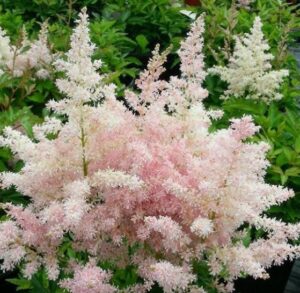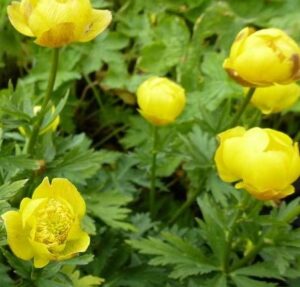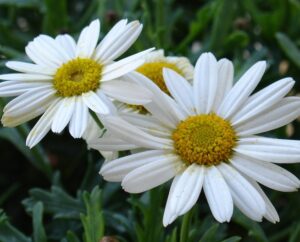Astilbe 'Europa', Trollius 'Lemon Queen' & Leucanthemum
‘No laurels in the guard-huts:
But out in the corn-meadows,
The peasant girl daisies
Wear their bonnets of stars …’

Victor Hugo thought a great deal about the difficult relationship between France and Prussia. His family were from the unstable border regions of France and Germany. He considers the problem in Le Rhin, a travel book published in 1842 and re-edited in 1845. He made three trips with Juliette Drouet in 1838, 1839, and 1840, and these voyages formed the basis of a collection of mostly fictitious letters describing a single tour of the Rhineland. In Hugo’s opinion, shared with many French intellectuals of the period, the civilisation nearest to the Ideal was that of Europe:
‘There exists today a European nationality … Despite the various short-term antipathies and quarrels over borders, all the civilised nations belong to the same centre and are indissolubly linked by a secret and profound unity. Civilisation gives us all the same guts, the same mind, the same goal, the same future.’ [Preface to Les Burgraves, 1843.]
In Victor Hugo’s eyes Europe did not include Britain: ‘it took 140 years for Shakespeare to cross [the Channel]’. This was an unusual view at the time: the commonplace was that the French were the intellectuals, the Germans the designers, and the British the engineers, and that for humanity to progress all three nations needed to work together. However, Hugo did not wish Britain to remain outside Europe. Britain’s problem, for him, was that it was, at the time, too self-centred. Its ‘knowing the value of everything’ and its desire for dominance made it dangerous. It was totally immured in the ‘Material’, while Europe was seeking for the Ideal.
‘Islands are made to serve continents, not to dominate them …’
Hugo did not envisage or desire a Europe without nations or nationalities. Two great nations, France and Germany, working together would enable Europe to progress in peace and prosperity. He acknowledged that hoping for universal peace may be utopian, but ‘utopias, when they have the same aim as humanity … are the facts of the next century.’ In order to achieve this utopia, the world needs railways, served by a marine network run by Britain and France, and – this is Victor Hugo, after all – to speak French. France was always the centre and prime mover for Hugo and those who shared his views. Eventually, even Britain would see the error of her ways, throw off materialism, and take her rightful place as the workshop and merchandiser of Europe. Of course there would be internal wars and revolutions; but once the reasons for mutual hatred had disappeared, Europe – and by extension eventually humanity – would attain universal peace.
Of course, Hugo’s opinions on religion, the monarchy and Europe changed over time and particularly with exile. As his views became Republican, so he dropped any idea that Europe might be made up of nation-states presided over by benevolent princes. Instead, he looks elsewhere for his model and begins to talk of The United States of Europe, culminating in the planting in the garden of Hauteville House of the oak of The United States of Europe. His toddler grandchildren plant it with him. Trees have their roots in the past but their leaves and branches in the future.
Hugo was invited to attend several Peace Congresses, where he made important speeches.
‘A day will come when the only fields of battle will be markets opening up to trade and minds opening up to ideas. A day will come when the bullets and the bombs will be replaced by votes, by the universal suffrage of the peoples, by the venerable arbitration of a great sovereign senate which will be to Europe what this Parliament is to England, what this Diet is to Germany, what this Legislative Assembly is to France. A day will come when we will display cannon in museums just as we display instruments of torture today, and are amazed that such things could ever have been possible. A day will come when we shall see those two immense groups, the United States of America and the United States of Europe, stretching out their hands across the sea, exchanging their products, their arts, their works of genius, clearing up the globe, making deserts fruitful, ameliorating creation under the eyes of the Creator, and joining together to reap the well-being of all.’

This golden-flowered perennial, known as the ‘globe flower’, has been planted in the herbaceous border to recall one of Victor Hugo’s favourite flowers, the buttercup, to which it is closely related. Plants of Hugo’s beloved common creeping buttercup, Ranunculus repens, have been planted in the ‘wild’ part of the Garden (section 5, north). The buttercup, the bouton d’or, or ‘golden button’, is strongly associated in Victor Hugo’s poetry with his mother, who died when Hugo was barely nineteen years of age.

Again, this cultivated daisy (Leucanthemum) reminds us of another of Hugo’s favourite meadow flowers. The daisy’s humble qualities were already a commonplace, having been made famous by Robert Burns, whose celebrated poem on the daisy George Métivier translated into Guernsey French.
In Hugo’s Unity, a short poem from Les Contemplations (1856), the sun is sinking over the fields at sunset. A humble daisy is growing on a crumbling wall (we might be reminded here of the St Peter Port daisy, Erigeron mucronatus):
‘And the little flower, over the old wall,
Stared at the great star in the eternal blue
Pouring out its immortal light over all:
She said: Why, I have beams too!
Granville, July 1836′
See: ‘The Franco-German Couple as the pillars of peace in Europe,’ in Catriona Seth, Rotraud von Kulessa, The Idea of Europe: Enlightenment perspectives, Cambridge University Press, 2017, pp. 153-55, and Franck Laurent, ‘L’Europe de la civilisation?‘, in Victor Hugo: Espace et politique (jusqu’a l’exil: 1823-1852), Presses Universitaires de Rennes, 2008, pp. 177-224,


